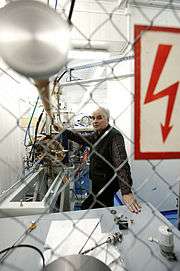Joint Institute for Nuclear Research
The Joint Institute for Nuclear Research (JINR, Russian: Объединённый институт ядерных исследований, ОИЯИ), in Dubna, Moscow Oblast (110 km north of Moscow), Russia, is an international research center for nuclear sciences, with 5500 staff members, 1200 researchers including 1000 Ph.D's from eighteen member states (including Armenia, Azerbaijan, Belarus and Kazakhstan). Most scientists, however, are eminent Russian scientists.
The Institute has seven laboratories, each with its own specialisation: theoretical physics, high energy physics (particle physics), heavy ion physics, condensed matter physics, nuclear reactions, neutron physics, and information technology. The institute has a division to study radiation and radiobiological research and other ad hoc experimental physics experiments.
Principal research instruments include a nuclotron superconductive particle accelerator (particle energy: 7 GeV), three isochronic cyclotrons (120, 145, 650 MeV), a phasotron (680 MeV) and a synchrophasotron (4 GeV). The site has a neutron fast-pulse reactor (1500MW pulse) with nineteen associated instruments receiving neutron beams.
Founding

The agreement on the establishment of JINR was signed on March 26, 1956 in Moscow, with Wang Ganchang and Vladimir Veksler among the founders.[1]
The institute was established on the basis of two research institutes of the USSR Academy of Sciences: the Institute for Nuclear Problems and the Electrophysical Laboratory.
Although the first research instrument was built at Dubna in 1947, it was not until the creation of CERN in 1954 that a countervailing group from the West was created—JINR.
Structure

The JINR has eight laboratories and University Centre:
- Bogoliubov Laboratory of Theoretical Physics (BLTP)
- Veksler and Baldin Laboratory of High Energies (VBLHE)
- Laboratory of Particle Physics (LPP)
- Dzhelepov Laboratory of Nuclear Problems (DLNP)
- Flerov Laboratory of Nuclear Reactions (FLNR)
- Frank Laboratory of Neutron Physics (FLNP)
- Laboratory of Information Technologies (LIT)
- Laboratory of Radiation Biology (LRB)
- University Centre (UC)
Experimental Physics workshops are also parts of the Institute.
Fields of research
The main fields of the Institute's research are:
- Theoretical physics
- Elementary particle physics
- Relativistic nuclear physics
- Heavy ion physics
- Low and intermediate energy physics
- Nuclear physics with neutrons
- Condensed matter physics
- Radiobiology
- Computer networking, computing and computational physics
- Educational programme
Discoveries
More than 40 major discoveries have been made.
- 1959 – nonradiative transitions in mesoatoms
- 1960 – antisigma-minus hyperon
- 1966 – element 102 (nobelium)
- 1972 – postradiative regeneration of cells
- 1973 – quark counting rule
- 1975 – phenomenon of slow neutron confinement
- 1988 – regularity of resonant formation of muonic molecules in deuterium
- 1999-2005 – elements 113 (nihonium), 114 (flerovium), 115 (moscovium), 116 (livermorium), and 118 (oganesson)
- 2006 – chemical identification of element 112 (copernicium)
- 2010 – successful synthesis of element 117 (tennessine)[2]
JINR Prize
In 1961 the JINR Prizes were instituted.
- JINR Prize 1961
- A group of physicists headed by Wang Ganchang, deputy director from 1958 to 1960 and the Soviet Professor Vladimir Veksler was awarded the first prize for the discovery of antisigma-minus hyperon. The experimental group led by Professor Wang Ganchang, analysed more than 40,000 photographs which recorded tens of thousands of nuclear interactions taken in the propane bubble chamber, produced by the 10 GeV synchrophasotron used to bombard a target forming high energy mesons, was the first to discover the anti-sigma minus hyperon particles on March 9, 1959:[3]
- The discovery of this new unstable antiparticle which decays in (1.18±0.07)·10−10 s into an antineutron and a negative pion was announced in September of that year:[4]
- No-one doubted at the time that this particle was elementary, but a few years later, this hyperon, the proton, the neutron, the pion and other hadrons had lost their status of elementary particles as they turned out to be complex particles too consisting of quarks and antiquarks.
Directors
- Dmitry Blokhintsev (1956–1965)
- Nikolay Bogolyubov (1966–1988)
- Dezső Kiss (1989–1991)
- Vladimir Kadyshevsky (1992–2005)
- Alexei Sisakian (2005–2010)
- Mikhail G. Itkis (May 2010–September 2011) ad interim
- Victor A. Matveev (2012– )
See also
References
- ↑ "International Intergovermental Organization Joint Institute for Nuclear Research" (PDF). Laboratory of High Energies of the Joint Institute for Nuclear Research. July 18, 2008. Retrieved August 12, 2008.
- ↑ Glanz, James (April 6, 2010). "Scientists Discover Heavy New Element". The New York Times.
- ↑ "50thAnniversary of the Veksler and Baldin Laboratory of High Energies of the Joint Institute for Nuclear Research" (PDF). Laboratory of High Energies of the Joint Institute for Nuclear Research. October 27, 2003. Retrieved August 11, 2008.
- ↑ "王淦昌的科学贡献". 电动力学网络教程. 2006-06-01. Retrieved August 4, 2008.
External links
Coordinates: 56°44′47″N 37°11′21″E / 56.746423°N 37.189268°E